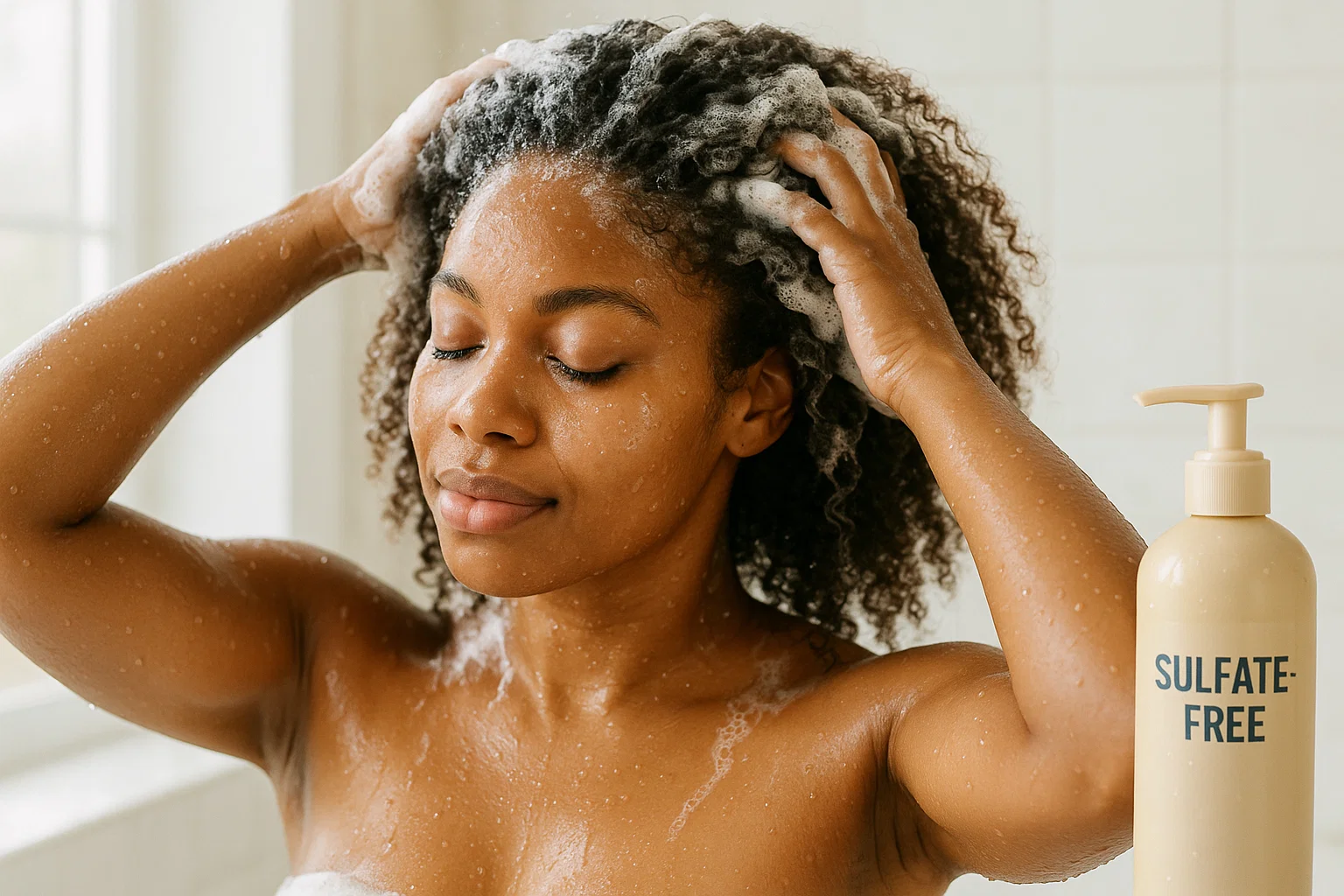Is Sulfate-Free Shampoo Good for Coarse Hair?
 Let’s be honest coarse hair can feel like a beautiful challenge. It’s strong, bold, full of personality… but also stubborn, dry, and sometimes rough to manage. If you’ve been fighting frizz or battling that “straw” texture, you’ve probably heard someone say, “Try sulfate-free shampoo.”
Let’s be honest coarse hair can feel like a beautiful challenge. It’s strong, bold, full of personality… but also stubborn, dry, and sometimes rough to manage. If you’ve been fighting frizz or battling that “straw” texture, you’ve probably heard someone say, “Try sulfate-free shampoo.”
But does that actually make a difference or is it just another label on a bottle? Let’s talk about what’s really happening when you swap your regular shampoo for a sulfate-free one, especially if you’ve got coarse or thick strands that need extra love.
What “Sulfate-Free” Really Means
Sulfates are detergents ingredients like sodium lauryl sulfate (SLS) or sodium laureth sulfate (SLES) that make shampoo foam and cut through oil. They’re powerful cleaners, but that strength can be too harsh on some hair types.
When a shampoo is labeled sulfate-free, it uses gentler surfactants such as sodium cocoyl isethionate, cocamidopropyl betaine, or decyl glucoside. These cleanse without stripping away all your natural oils.
For coarse hair, that’s a big deal. Your strands already have a wider diameter and lower moisture retention than fine hair. Losing those natural oils can turn coarse hair brittle fast.
Quick Fact:
A 2023 cosmetic-science review in the Journal of Cosmetic Dermatology found that sulfate-free surfactants maintain up to 30% more natural lipids in the hair shaft compared to SLS-based shampoos.
Why Coarse Hair and Sulfates Don’t Always Get Along
Here’s the truth: coarse hair thrives on moisture and softness. Sulfates remove dirt but they also lift the outer cuticle layer of your hair. That raised cuticle makes coarse strands feel rough, dull, and tangled.
If your hair is already dry or textured, sulfates can exaggerate that. Over time, you might notice split ends, increased breakage, or that crunchy feeling even after conditioning.
What research says:
A consumer study by Allure found that 72% of people with coarse or curly hair felt their strands were “softer and easier to detangle” after switching to sulfate-free shampoo for just three weeks.
Bottom line: coarse hair and sulfates usually don’t mix well.
But Let’s Clear a Myth: Not All Sulfates Are Evil
Sulfates aren’t villains they just need context. If your scalp is very oily, or you use a lot of styling products, an occasional sulfate-based wash can help clarify buildup. Think of it as a “reset day.”
The trick is balance. If your hair feels squeaky-clean, it might be too clean. Coarse hair doesn’t bounce back quickly from oil loss it takes deep conditioning and time to rebuild that lipid barrier.
So yes, sulfates have their place. But for everyday washing, coarse hair is happier without them.
What Happens When You Switch to Sulfate-Free Shampoo
At first, your hair might feel different. Less foamy. Less squeaky. That’s normal. The natural oils your scalp produces start to rebalance, and your strands keep more moisture inside.
Within a few washes, coarse hair begins to feel more pliable less stiff, more hydrated. The texture softens. Flyaways calm down. The shine returns naturally because the cuticle stays smoother.
What users notice most:
- Easier detangling
- Softer ends after air-drying
- Better curl or wave definition
- Longer color life for dyed hair
These improvements don’t happen overnight, but give it two to four weeks and you’ll see why sulfate-free lovers never go back.
Choosing the Right Sulfate-Free Shampoo for Coarse Hair
There’s no one perfect bottle, but look for these things on your label:
1. Moisturizing surfactants – ingredients derived from coconut or sugar (like decyl or coco glucoside).
2. Nourishing oils – argan, marula, shea butter, or avocado oil to coat and soften coarse strands.
3. Proteins in moderation – hydrolyzed keratin or silk can fill gaps in rough cuticles but don’t overuse them.
4. Balanced pH (around 4.5–5.5) – keeps your cuticle sealed and your hair smooth.
5. Silicone-free or lightweight silicones – too many silicones can coat coarse hair and block moisture over time.
Ingredient Breakdown Example:
A formula with sodium cocoyl isethionate, glycerin, argan oil, and panthenol (vitamin B5) hits the sweet spot for hydration, shine, and manageability.
Who Might Not Need Sulfate-Free Shampoo
Some people actually do fine with mild sulfates especially if they have fine, oily, or limp hair that gets weighed down easily. Sulfate-free shampoos can sometimes leave buildup or feel too heavy for those hair types.
So if your hair is coarse, dry, or color-treated yes, sulfate-free is usually great.
If it’s thin, oily, or you wash daily you might prefer alternating between both kinds.
Hair care isn’t one rule fits all; it’s trial, feel, and observation.
Does Sulfate-Free Shampoo Make Hair Softer?
Absolutely and science backs that up. Sulfate-free cleansers leave behind more of your scalp’s natural sebum, which acts as a built-in conditioner. Combined with moisturizing agents like glycerin or plant oils, your strands retain elasticity and shine.
In tests done by cosmetic formulators (INCIdecoder database, 2024), sulfate-free formulations improved surface smoothness by up to 22% after four washes compared to conventional shampoos.
So yes, softness isn’t an illusion it’s chemistry at work.
How to Use Sulfate-Free Shampoo the Right Way
A few small tweaks can help your coarse hair get the most from your new routine:
- Wet thoroughly first. Gentle cleansers need water to spread evenly.
- Use a little more product. Because it doesn’t foam much, add small amounts in sections rather than dumping it all at once.
- Massage longer. Work the scalp with your fingertips for 60–90 seconds to lift dirt and oils.
- Rinse fully. Residue can make hair feel waxy if left behind.
- Follow with a conditioner or mask. Coarse hair loves moisture sealing.
Once or twice a month, do a clarifying rinse (apple cider vinegar or gentle sulfate wash) if you use styling products often.
Common Mistakes When Going Sulfate-Free
- Expecting instant results – it takes a few washes for your hair’s oil balance to reset.
- Using hot water – it opens cuticles and defeats the purpose of gentle cleansing.
- Skipping conditioner – sulfate-free shampoos are mild, but you still need that moisture lock afterward.
- Not reading ingredients – “sulfate-free” on the front doesn’t always mean gentle; check for other harsh agents.
Real-World Example
When I tested a few sulfate-free lines on clients with coarse, color-treated hair, the difference after a month was clear: less frizz, more flexibility. One client said her hair finally moved again instead of sitting stiff and dry. That’s the hallmark of healthy cuticles staying smooth and hydrated.
The Verdict
So is sulfate-free shampoo good for coarse hair?
Yes, in most cases, it’s exactly what coarse hair needs. It cleanses gently, preserves essential oils, softens texture, and helps moisture stay where it belongs inside your hair shaft.
It’s not magic. It’s just smarter chemistry that respects the nature of your hair instead of fighting it.
If you’ve been struggling with roughness, frizz, or dryness, give a sulfate-free formula a genuine try. Pair it with a hydrating conditioner or weekly mask. After a few washes, you’ll understand what people mean when they say their hair finally feels alive again.

With over 10 years of experience, Emily Turner provides expert reviews on hair care products. Passionate about sustainable beauty solutions, she helps readers achieve beautiful, healthy hair.